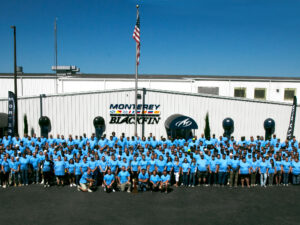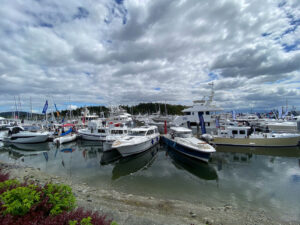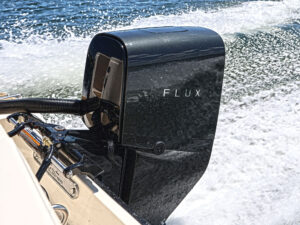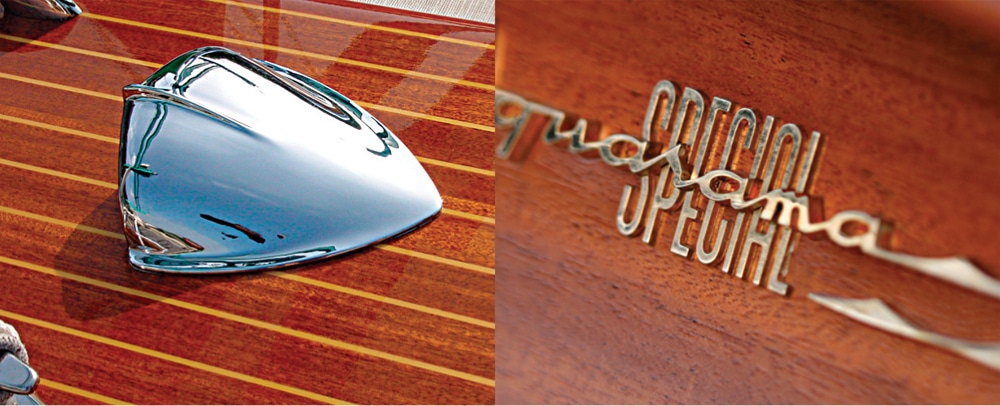
Wooden Boat Ownership
In early 2011, a 1996 Riva Aquarama Special Hull 774, a wood speedboat inspired by a vintage Hacker-Craft runabout, sold to an anonymous bidder at auction for $975,000. It was the biggest item in terms of dollar volume sold at this particular auction.
Why would someone spend nearly a million dollars on a 15-year-old runabout? Part of the reason is likely that this particular boat, considered by some to be the Ferrari of the boating world , was the last of its kind ever produced by the legendary Italian builder. An equal part, however, would arguably be the growing fascination with vintage wooden boats.
Nostalgic nods to the sport’s golden era, vintage models fetch premium prices at auctions and inspire enthusiasts to sand and varnish till their knuckles bleed, all for the pleasure of simply gazing at (and one can hope cruising in) a piece of history. For these select few, owning a classic wooden boat represents one of boating’s great joys.
Here are some of their stories, as well as suggestions on how to acquire one of these classic beauties for yourself.
Who Buys Woodies?
Fans of antique wooden boats run the gamut, in terms of finances, passion and motivation. For some at the highest ends of the market, it’s admittedly the desire to own something few others can obtain. Jim Genovese, owner of Sandy Beach Marina in Akron, Ohio, recently spent $130,000 on a pristine 1955 Chris-Craft Cobra, a design distinguished by the prominent gold fin protruding from its afterdeck. Genovese first saw a Cobra 20 years ago. He’d wanted one ever since.
“It’s a very unique boat,” explains Genovese. “It has a fin; it has a Hemi motor. There are approximately 60 to 70 of these boats left out of the 105 that were built, so it’s very rare.”
Genovese admits to being the kind of guy who likes to show off his collectibles. That Cobra sits in front of a lakeside house that features an indoor showroom for a collection of classic cars, readily seen from the water behind $150,000 worth of plate glass. “I guess it’s just another thing to feed your ego,” he offers. “I feel like I have the holy grail of Chris- Crafts. If you’re going to have one … that’s the one to have.”
For others, owning an antique boat is a chance to hold onto something special from the past. Dr. Bob Johnson, a retired family physician, remembers his uncle letting him steer classic woodies as a child, and being drawn to the gleaming speedboats tied up in the local marina. As an adult, he has purchased a succession of open speedboats. His favorites? The iconic Chris-Craft U-22 Sportsman, of which he’s owned four or five, and the recent addition of a 1929 Hickman Sea Sled.
“Hickman was a very unusual guy,” Johnson recounts. “He developed a surface-piercing propeller and a tunnel hull, all in the 1920s.” In addition, the builder used engine technologies now popular more than 80 years later, such as oil coolers. “A lot of these people were ahead of their time,” Johnson says.
Pining for the Past
Obviously, there’s more to this picture than simple lust over a finely varnished mahogany plank. Wood is the obvious constant, a material both beautiful and functional, and one that, historically speaking, was frequently used in intricate, aesthetically appealing ways.
“Architecturally, the designs are just fantastic,” says Classic Marine owner Dwight Davis, a man who not only grew up with wood boats, but one who also now shares his knowledge at a local maritime museum. “Wood is just so alive and so beautiful. The way a boat comes together when it’s built out of wood, all the pieces, all the ribs and the structural parts, to me it’s just really fantastic. Wood’s strength equals its beauty.”
Look at the most coveted models and you’ll see wood in all its glory. Pre-World War II models are perhaps most rare and, as a result, most sought after by high-end collectors. Boats like the Gar Wood Triple Cockpit Runabout or Baby Gar, or anything from Dodge, Hacker, Dolphin or Gold Cup. Prewar Chris-Crafts are also a hot commodity, as are postwar models like Genovese’s Cobra.
Wood, however, also tells a story to those who’ll listen. “You find a 1937 Gar Wood 28-foot Triple Cockpit runabout with a Scripps V-12 302 in it, and that boat’s been owned by Marshall Fields, or some high-powered guy out in LA,” Freedom Boat Service partner Aaron Kelly explains. “It has a lot of history, and that’s what draws a lot of people into this.”
It’s these elite models of the 1920s that typically draw the big bidders. But like other fine works of art, they often need middlemen to arrive in the hands of their collectors. For the elite investor, that might mean using a specialty firm like Freedom. Here, specialists such as Kelly and founder Dave Bortner interview clients to determine which boat best fits their needs, research what’s available and then provide detailed dossiers on the potential candidates. Once a sale is negotiated, Freedom also offers full restoration services, from hulls to vintage engines.
“A lot of times on some of this prewar stuff, you can’t get parts anymore, so you have to fabricate stuff,” Kelly explains. “We spend thousands of dollars sometimes just remanufacturing a cleat or a windshield bracket or a navigation light. It’s big business, and it takes money to do what we do.”
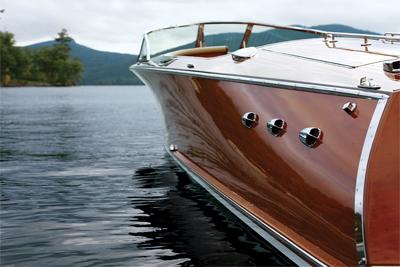
Doing It Yourself
Others, however, find part of the joy of owning a classic is in getting their hands dirty. It’s estimated that 60 to 70 percent of antique boat buyers are do-it-yourself types. Many of them have worked on a family boat with a previous generation and want to pass that experience along to their children. Others find the frequent upkeep almost therapeutic.
“With a car or fiberglass boat, the relationship is very one-sided,” Davis says. “But with a wood boat, we work on it in the off-season, and that’s still part of the relationship with the boat, the care and the responsibility.
“It’s not, ‘I just want to get a couple more seasons out of the boat.’ Owners see this thing as carrying on essentially forever. They’ll continue to be taken care of, and years from now they expect them to be out there and running.”
“I like the varnishing and painting, the sanding and scraping,” admits Johnson, a self-described “exaggerated” hobbyist. Johnson has experience with both turnkey models and boats that have required renovation. Think the latter is a money saver? You might be surprised. “It’s a lot cheaper to buy one that’s already done!” Johnson says, laughing. “There’s no doubt about that.”
Classic Marine’s Davis knows both types of consumers. “There are some professional types — all they want to do is turn the key,” he says. “We do the varnish, the woodworking; we even have some that we make sure are washed and ready to start when the customer gets in town. But there are other customers that all they want is a little bit of advice.”
That advice is doled out through a variety of resources. A kindhearted restorer is certainly one, but more common are the local antique boat clubs. Here, members meet other boaters, who frequently share the same interests and needs. They talk to each other, see who’s using whom for work and swap tales on who’s expensive, who’s reliable, who takes too long and who’s fast on the job.
Many clubs also put on educational workshops over the wintertime. These workshops typically cover everything from troubleshooting engines and electronics to woodworking, varnishing and painting. Clubs also often put together social trips on which owners can use their boats as the manufacturer originally intended.
“I like using my boats,” says Johnson, who readily admits his U-22 is no trailer queen. “And I like going out on these river and lake cruises that are organized through our club. There’s a big social aspect to it.
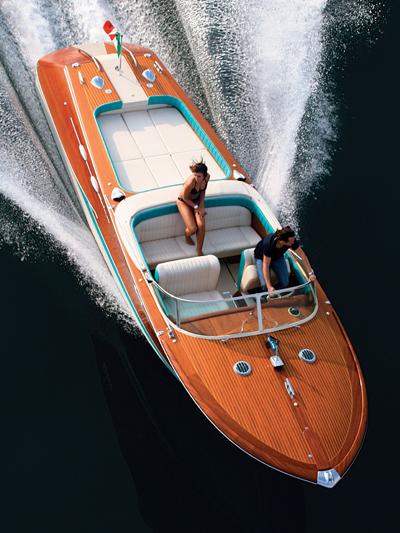
Purchasing Your Pearl
How do you acquire one of these wooden wonders for yourself? Prospective buyers typically turn to one of the aforementioned resources — antique boat clubs, brokers, restoration experts or auctions. All can be easily located on the Internet.
Mecum Auctions, for instance, has a long history of auctions in the classic car markets, and its auction of the renowned Todd Warner wood boat collection this past fall brought all of the sources for our story together. Kelly purchased four boats (two 1958 Chris-Craft Sea Skiffs, a 1995 Hacker racing replica and a 1948 Sudlow); Johnson picked up three (a 1929 Hickman Sea Sled, a 1953 racing runabout and a 1970 Evinrude boat, along with five engines and two additional pallets of parts); Davis purchased three antique engines; and Genovese found his beloved Cobra. Genovese originally planned to attend to bid on a car, until he saw the Cobra on the list. Then his mind was made up.
Davis cautions, however, that auctions are not without certain perils. “It would probably be about the worst case for a newcomer,” he says. “You can’t survey the boat; you can’t really look around. You have to know what you’re looking at.”
Davis advises the budget-conscious newcomer to start with someone who is a restorer, but not necessarily a broker or seller. They know the boats in their area that are coming to market and usually will take the time to help.
“Let’s face it, a guy isn’t restoring wooden boats unless it’s his passion,” he says. “If you go to boat shows and get to know some of the guys in the club, they’ll often know who’s got a boat for sale, who just passed away, what boat’s been sitting in a barn for years. They can also find out what kind of boat is really right for that person.”
So is vintage wood right for you?
Davis says: “We live in a society that has a lot of issues, but at the end of the day, when you go out in your wooden boat and you see all that varnish, and everything is shaped with beautiful curves, it’s like, ‘Wow, this is really great.’ I can just breathe it in!”
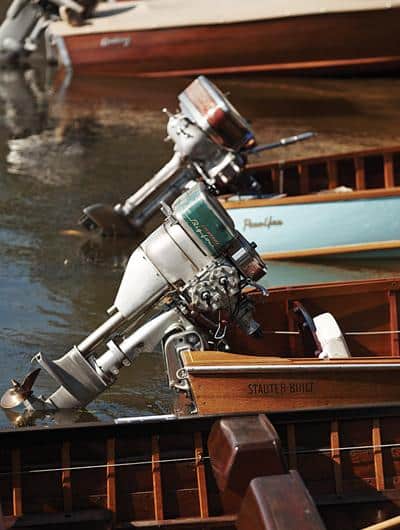
What Price Beauty?
Jim Genovese first saw his Chris-Craft Cobra sell for $40,000 in the early 1980s. In late 2010, he paid $130,000. In five years, he contends it will be worth almost $500,000. Hence, these boats may be one of the better investments today. But one of the most challenging aspects of buying an antique boat is determining a fair price.
“It’s easy to calculate depreciation on antique classic boats that manufacturers built a lot of,” Freedom Boat Service’s Aaron Kelly says. “Where it becomes tricky is determining the value of boats that they built only 28 of, and maybe there’s only 10 still in existence. How do you put a value on something like that? It’s almost impossible.
“They’re worth what someone is willing to pay.”
Kelly says: “I would put antique classic boats in the same realm as gold, silver and oil.”
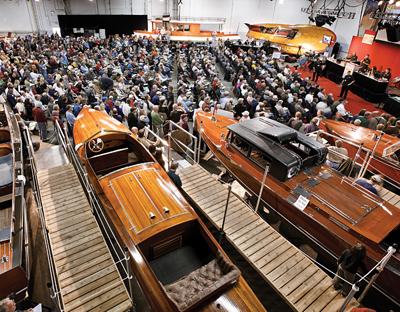
Build or Buy
Most boat history buffs point to the mid-1960s as the turning point from wood to fiberglass. But even today, several wood-boat manufacturers are still cranking out new models. And for the intrepid DIY guy, there are some kit or plan builders too. Here are a few:
Hacker — One of the few and arguably most popular builders today, it produces mahogany sport boats from the keel up to suit your fondest dream.
Glen-L Marine — Want to build your own? Glen-L offers plans and patterns for building runabouts, cruisers, skiffs and racers — you imagine it, they have a plan.
Grand-Craft — It offers a line of vintage-inspired runabouts.
Skiff Craft — Lapstrake models span a 24- to 33-foot range.
Saetta Boats — It uses CNC technology to craft its Saetta Sport Boat Kit in Zellwood, Florida.
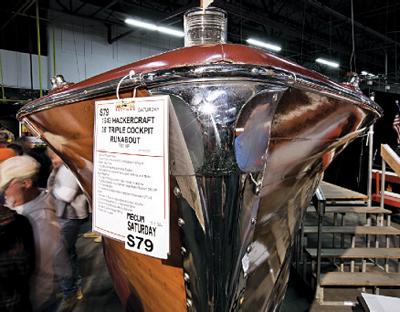
Brokers/Restorers
Here are a few organizations that can help you find and buy a classic, as well as provide restoration:
Antique Boat America (antiqueboatamerica.com) — Offers a vast inventory of classic wooden boats of all makes and styles.
Freedom Boat Service (freedomboatservice.com) — Buying, selling and restoring services.
Mecum Auctions (mecum.com) — A classic car specialist that has expanded into antique boats.
Antique Boat Clubs
Arguably the best way to get started in the wooden-boat game is to join a club. Here are three:
Antique & Classic Boat Society (acbs.org) — The largest resource, with Canadian and U.S. chapters.
Century Boat Club (centuryboatclub.com)
The Gar Wood Society (garwood.com)

